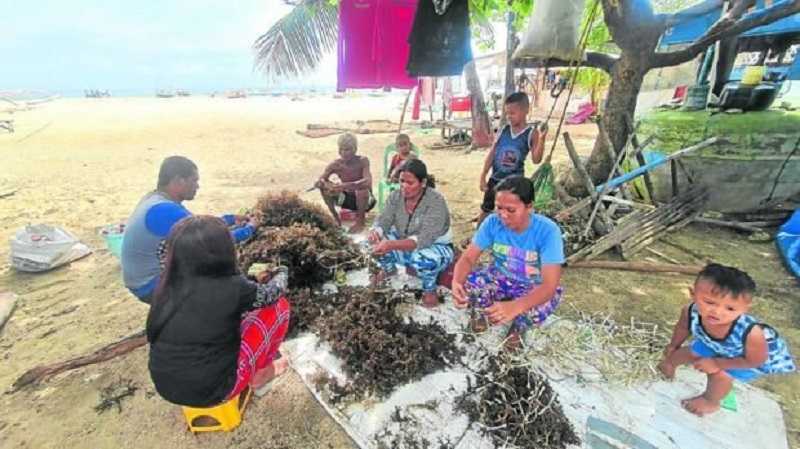
Mambacayao Island, one of the many fishing communities that consider the Tanon Strait their lifeline.
13:39 JST, June 23, 2022
For decades, the fisherfolk of Mambacayao Island — a small islet that is part of the Bantayan Group of Islands in Northern Cebu — depended on the rich Tanon Strait for their livelihood.
John Ortega said that in the past, the small boats that he and other fishermen used would almost capsize from the weight of the 20 kilograms of fish that each of them caught daily. They would sell their haul of groupers, mackerel, herring, and even manta rays and baby sharks in the local markets and some they’d whip into sumptuous dishes at home.
Now, he said they would be lucky to get two kilos from a whole day out at sea. They now mostly catch the plastic and other garbage that are contaminating one of the largest marine protected areas in the country.
“Before, we would only see images of turtles that have straws in their noses on TV,” Ortega said. “Now when we cut open some fish, we would find traces of plastic. [We’re] worried that we’ve been eating contaminated fish.”
Science is backing his fears. A 2021 study by the Coastal Resources and Ecotourism Research, Development and Extension Center (Crerdec) of the Ecosystems Research and Development Bureau (ERDB) have found traces of microplastics, or plastic debris, in at least 10 marine sites across the archipelago.
The study found that the highest concentration of plastic pollutants was in the Tanon Strait, the 160-kilometer emerald waters separating Negros and Cebu islands and one of the most productive fishing grounds in the country.
Jon Alfonso Horvidalla, science research specialist and study leader, said the findings were “alarming” as they affect both the marine life in the strait and the communities around it.
“We’re no longer certain that what [they] are eating has not yet been contaminated by plastic,” said Jim Padin, Crerdec supervisor.
Damage at cellular level
Nearly all microplastics originate from plastic waste products that are dumped directly into the ocean or in inland waterways that empty into the sea.
Due to weathering, wave action, exposure to sunlight and other elements in the open sea, plastic degrades into microscopic sizes of between 20 to 5,000 microns (half a centimeter). One micron is one-millionth of a meter.
Citing multiple international studies, Horvidalla said these microplastics were found to be “retained inside body tissues of living things” and can cause damage to cell walls. It also compromises coral health and can “amplify coral’s exposure to other stressors.”
At present, most studies on microplastics focus on its impact on marine life. However, there is considerable literature showing that microplastics can cause inflammation, cell death and DNA damage in laboratory animals and cell cultures.
Lifeline for many
The Tanon Strait protected seascape is home to several rare and endangered marine animals moving between the Visayan Sea in the north and the Bohol Sea in the south. In 1998, it was declared a protected seascape in honor of the 14 species of whales and dolphins living there.
It’s also a major fishing ground for Cebuano fisherfolk, who became increasingly dependent on its bounty during the pandemic. The Philippine Statistics Authority reported last year that at least 530,000 Cebuanos sank below the poverty threshold following the drop in tourism revenue in the previous two years.
They included some of the fishermen of Mambacayao and Barili, another coastal municipality southwest of Tanon. Before the pandemic, they used to sell their catch to beach resorts, said fisherfolk leader Ven Carbon.
“When they closed down [during the pandemic,] not only were we catching fewer fish, but we struggled to sell them because everyone was hard up, too,” Carbon said. Many small-scale fishermen left for the city to work as carpenters or drivers to put food on the table, he said.
Huge problem
As in most coastal areas in the country, plastic is a huge problem for the Tanon fisherfolk, said Ortega, who leads the local Tanon Strait Fisherfolk Federation.
Plastic sachets, bottles and labo end up on the seafloor where marine animals mistake them for food, or they are washed up on the shores, which locals call “gapnod.”
“We would sometimes wake up to see garbage lined up along the shore especially when there are strong waves. It’s mostly single-use plastic, but there are also batteries [thrown away by fishermen during their night fishing,]” said Vince Dacomos.
During one of their regular coastal cleanups, Dacomos, 26, and his friends were able to fill an entire sack with discarded batteries in less than one hour.
In Barili, plastic ends up entangled in the roots of the mangrove forests on the shoreline.
“Because mangroves are also nurseries for fish like sardines and bolinao [whitebait fish], the plastic ends up choking them,” Carbon said.
This is not an isolated case. Most of the country’s waters are heavily polluted with plastic and other garbage, mostly because of weak enforcement of environmental and waste management laws, said Gloria Estenzo Ramos, vice president of Oceana.
"World" POPULAR ARTICLE
-

8 Japanese Nationals Stranded on Indonesia’s Sumatra Island
-

U.S. Senate Resolution Backs Japan, Condemns China’s Pressure
-

China to Impose Sanctions on Shigeru Iwasaki, Former Head of Japan’s Self-Defense Forces, Who Serves as Adviser to Taiwan’s Executive Branch
-

South Korea’s Top Court Dismisses Nippon Steel Appeal in Lawsuit over Requisitioned Worker
-

75% of Myanmar People Reject Army’s Political Involvement, According to Survey Conducted by Aid Organization
JN ACCESS RANKING
-

Tokyo Economic Security Forum to Hold Inaugural Meeting Amid Tense Global Environment
-

Keidanren Chairman Yoshinobu Tsutsui Visits Kashiwazaki-Kariwa Nuclear Power Plant; Inspects New Emergency Safety System
-

Imports of Rare Earths from China Facing Delays, May Be Caused by Deterioration of Japan-China Relations
-

University of Tokyo Professor Discusses Japanese Economic Security in Interview Ahead of Forum
-

Japan Pulls out of Vietnam Nuclear Project, Complicating Hanoi’s Power Plans
























